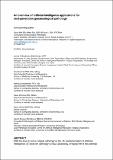Files in this item
An overview of artificial intelligence applications for next-generation gynaecological pathology
Item metadata
| dc.contributor.author | Bell, Sarah | |
| dc.contributor.author | Blackwood, James D. | |
| dc.contributor.author | Fell, Christina | |
| dc.contributor.author | Mohammadi, Mahnaz | |
| dc.contributor.author | Morrison, David | |
| dc.contributor.author | Harris-Birtill, David | |
| dc.contributor.author | Bryson, Gareth | |
| dc.date.accessioned | 2023-09-29T10:30:02Z | |
| dc.date.available | 2023-09-29T10:30:02Z | |
| dc.date.issued | 2023-10-01 | |
| dc.identifier | 291720794 | |
| dc.identifier | 86823537-e513-4e75-8575-221f0a57b08b | |
| dc.identifier | 85166240087 | |
| dc.identifier.citation | Bell , S , Blackwood , J D , Fell , C , Mohammadi , M , Morrison , D , Harris-Birtill , D & Bryson , G 2023 , ' An overview of artificial intelligence applications for next-generation gynaecological pathology ' , Diagnostic Histopathology , vol. 29 , no. 10 , pp. 442-449 . https://doi.org/10.1016/j.mpdhp.2023.07.002 | en |
| dc.identifier.issn | 1756-2317 | |
| dc.identifier.other | RIS: urn:A6C15A484C4A77B5086A58BEE8C539D3 | |
| dc.identifier.other | ORCID: /0000-0001-5502-9773/work/139965408 | |
| dc.identifier.other | ORCID: /0000-0002-0740-3668/work/139965443 | |
| dc.identifier.uri | https://hdl.handle.net/10023/28473 | |
| dc.description | Funding: The work described in the section Creation of a Scottish ‘living lab’ for AI development is part of iCAIRD which is funded by Innovate UK on behalf of UK Research and Innovation (UKRI), project number 104690. | en |
| dc.description.abstract | With the drive to roll out digital pathology in the UK, implementation of artificial intelligence (AI) tools for pathology is now a possibility, bringing with it the potential to change how we work as a specialty. AI promises many benefits for working practices such as improved efficiency and consistency, financial and productivity gains and ultimately a better service for our patients. Gynaecological pathology is a diverse specialty with many potential avenues for algorithm development, yet there are relatively few nearing clinical validation compared to other pathology specialties. This article provides a summary of the current landscape of AI in pathology with a focus on applications in gynaecological pathology. We discuss the ways pathologists can be involved in algorithm development and draw on our significant experiences in a nationally funded programme for AI development and research. Finally we look to what the future might hold. | |
| dc.format.extent | 8 | |
| dc.format.extent | 2042189 | |
| dc.language.iso | eng | |
| dc.relation.ispartof | Diagnostic Histopathology | en |
| dc.subject | Artificial intelligence | en |
| dc.subject | Computational pathology | en |
| dc.subject | Deep learning | en |
| dc.subject | Digital pathology | en |
| dc.subject | Gynaecological pathology | en |
| dc.subject | Whole slide images | en |
| dc.subject | QA75 Electronic computers. Computer science | en |
| dc.subject | RB Pathology | en |
| dc.subject | RG Gynecology and obstetrics | en |
| dc.subject | T-NDAS | en |
| dc.subject | AC | en |
| dc.subject | MCC | en |
| dc.subject | NCAD | en |
| dc.subject.lcc | QA75 | en |
| dc.subject.lcc | RB | en |
| dc.subject.lcc | RG | en |
| dc.title | An overview of artificial intelligence applications for next-generation gynaecological pathology | en |
| dc.type | Journal article | en |
| dc.contributor.sponsor | Technology Strategy Board | en |
| dc.contributor.institution | University of St Andrews. School of Medicine | en |
| dc.contributor.institution | University of St Andrews. Statistics | en |
| dc.contributor.institution | University of St Andrews. School of Computer Science | en |
| dc.contributor.institution | University of St Andrews. Centre for Research into Ecological & Environmental Modelling | en |
| dc.identifier.doi | 10.1016/j.mpdhp.2023.07.002 | |
| dc.description.status | Peer reviewed | en |
| dc.identifier.grantnumber | TS/S013121/1 | en |
This item appears in the following Collection(s)
Items in the St Andrews Research Repository are protected by copyright, with all rights reserved, unless otherwise indicated.

